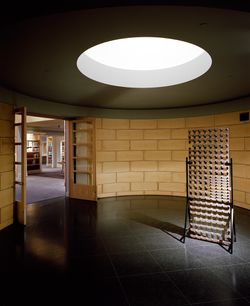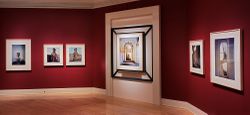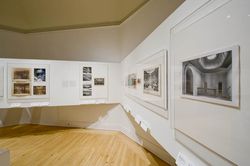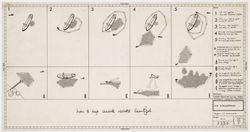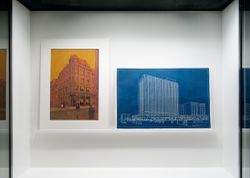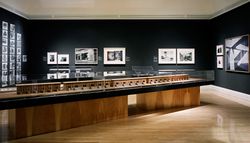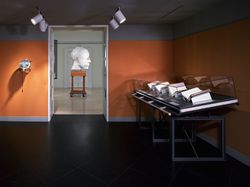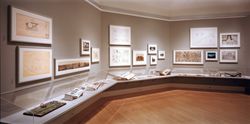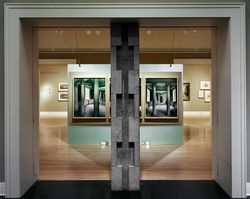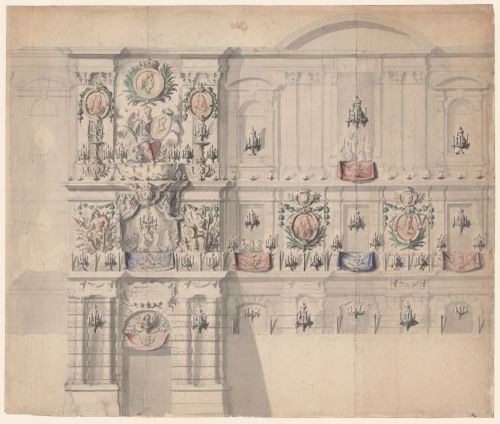The Idea of the Penitentiary
This exhibition explores the notion of penitentiary, which worked its way into the consciousness and across the landscape of Europe and North America during the nineteenth century. Drawing upon the growing rationalist tendencies in architecture and social theory during the eighteenth century, proponents of penitentiary emphasised a clear geometry of separation,(...)
Hall cases
8 November 1995 to 31 May 1996
The Idea of the Penitentiary
Actions:
Description:
This exhibition explores the notion of penitentiary, which worked its way into the consciousness and across the landscape of Europe and North America during the nineteenth century. Drawing upon the growing rationalist tendencies in architecture and social theory during the eighteenth century, proponents of penitentiary emphasised a clear geometry of separation,(...)
Hall cases
Visions and Views combines contemporary photography and engravings from the seventeenth and eighteenth centuries to establish a dialogue between two different approaches to representing Francesco Borromini’s built work. The photographs, part of a larger commission acquired by the CCA, were taken in Rome by Toronto photographer Edward Burtynsky in 1999. They are presented(...)
Octagonal gallery
15 March 2000 to 7 May 2000
Visions and Views: The Architecture of Borromini in the Photographs of Edward Burtynsky
Actions:
Description:
Visions and Views combines contemporary photography and engravings from the seventeenth and eighteenth centuries to establish a dialogue between two different approaches to representing Francesco Borromini’s built work. The photographs, part of a larger commission acquired by the CCA, were taken in Rome by Toronto photographer Edward Burtynsky in 1999. They are presented(...)
Octagonal gallery
Toplight: Roof Transparencies from 1760 to 1960 traces the evolution of skylights from their origins at the end of the eighteenth century, when this type of fenestration was first explored in Paris’s new Halle au blé (1763–1782), to James Stirling’s History Faculty Building, University of Cambridge (1963–1968). The exhibition is organized around a series of case studies(...)
Octagonal gallery
23 October 2008 to 15 February 2009
Toplight: Roof Transparencies from 1760 to 1960
Actions:
Description:
Toplight: Roof Transparencies from 1760 to 1960 traces the evolution of skylights from their origins at the end of the eighteenth century, when this type of fenestration was first explored in Paris’s new Halle au blé (1763–1782), to James Stirling’s History Faculty Building, University of Cambridge (1963–1968). The exhibition is organized around a series of case studies(...)
Octagonal gallery
Environmental Histories
To kick off “Architecture and/for the Environment” —the CCA’s third Multidisciplinary Research Project funded by the Andrew W. Mellon Foundation—Daniel Abramson and Imre Szeman will present two key concepts that reconceive the environment in the history of architecture. Daniel Abramson, an architectural historian, will discuss how the idea of architectural “obsolescence”(...)
Paul Desmarais Theatre
15 December 2016, 6pm
Environmental Histories
Actions:
Description:
To kick off “Architecture and/for the Environment” —the CCA’s third Multidisciplinary Research Project funded by the Andrew W. Mellon Foundation—Daniel Abramson and Imre Szeman will present two key concepts that reconceive the environment in the history of architecture. Daniel Abramson, an architectural historian, will discuss how the idea of architectural “obsolescence”(...)
Paul Desmarais Theatre
Starting from... People
One of the markers of modernity from the eighteenth century onwards is the emergence of “the people” as a respected political entity. In response, architects have advocated for the transformation of cities, explored new technologies, pioneered design discourses, and engaged in heated cultural conflicts—all in the name of the people. During this time, fictional, abstracted(...)
Hall cases
5 October 2011 to 22 January 2012
Starting from... People
Actions:
Description:
One of the markers of modernity from the eighteenth century onwards is the emergence of “the people” as a respected political entity. In response, architects have advocated for the transformation of cities, explored new technologies, pioneered design discourses, and engaged in heated cultural conflicts—all in the name of the people. During this time, fictional, abstracted(...)
Hall cases
Marking the 10th anniversary of the CCA’s public opening, the exhibition spotlights and juxtaposes acquisitions from its first decade. Over 350 prints, drawings, photographs, rare books, manuscripts, toys, and models spanning five centuries of architectural history reflect how the built world has been imagined, conceived, and reflected upon. Dedicated to the many donors(...)
Main galleries and hall cases
24 November 1999 to 30 April 2000
En chantier: The Collections of the CCA, 1989-1999
Actions:
Description:
Marking the 10th anniversary of the CCA’s public opening, the exhibition spotlights and juxtaposes acquisitions from its first decade. Over 350 prints, drawings, photographs, rare books, manuscripts, toys, and models spanning five centuries of architectural history reflect how the built world has been imagined, conceived, and reflected upon. Dedicated to the many donors(...)
Main galleries and hall cases
Meditations on Piero presents contemporary sculptures by British/Canadian artist Geoffrey Smedley alongside over thirty rare books from the fifteenth to the eighteenth centuries. The sculptures draw their inspiration from a series of drawings of the human head by the great Italian Renaissance artist Piero della Francesca. The exhibition relates these drawings and(...)
Octagonal gallery
2 May 2001 to 16 September 2001
Meditations on Piero
Actions:
Description:
Meditations on Piero presents contemporary sculptures by British/Canadian artist Geoffrey Smedley alongside over thirty rare books from the fifteenth to the eighteenth centuries. The sculptures draw their inspiration from a series of drawings of the human head by the great Italian Renaissance artist Piero della Francesca. The exhibition relates these drawings and(...)
Octagonal gallery
Cedric Price: Mean Time
British architect Cedric Price draws upon the collection of the CCA to develop the complex relationships between time, movement, and space in the built environment. Looking at structures and building elements through the ages, including some of Price’s own projects, Mean Time presents photographs of an ancient Aztec sun dial, a railroad switching yard, a shot tower, and a(...)
Octagonal gallery
19 October 1999 to 27 February 2000
Cedric Price: Mean Time
Actions:
Description:
British architect Cedric Price draws upon the collection of the CCA to develop the complex relationships between time, movement, and space in the built environment. Looking at structures and building elements through the ages, including some of Price’s own projects, Mean Time presents photographs of an ancient Aztec sun dial, a railroad switching yard, a shot tower, and a(...)
Octagonal gallery
Just as Andrea Palladio’s Villa Rotonda helped to define for future generations the architecture of the Renaissance in Italy, so Chiswick is the locus classicus of the Palladian Revival of the eighteenth century. This exhibition follows a major architect’s thinking as he worked from source to design, from design to representation, in the making of a building which, as the(...)
Main galleries
19 July 1994 to 25 September 1994
The Palladian Revival: Lord Burlington, His Villa and Garden at Chiswick
Actions:
Description:
Just as Andrea Palladio’s Villa Rotonda helped to define for future generations the architecture of the Renaissance in Italy, so Chiswick is the locus classicus of the Palladian Revival of the eighteenth century. This exhibition follows a major architect’s thinking as he worked from source to design, from design to representation, in the making of a building which, as the(...)
Main galleries
DR1967:0012
Description:
The drawing shows an elevation of the Porte Jean Goujon (now known as the Porte Barbet de Jouy) on the southern, quai-side façade of the Louvre, as well as part of the façade to the east of the portal. On the ground floor, candelabras line the windows and niches. The entry portal features a sculptural bust – likely a representation of Louis XIV – and a red banner with the king’s coat of arms. Above the portal’s tympanum is a large ovoid cartouche with faint script in black chalk that may read « Plate pour l’inscription, » indicating that the text had not yet been finalized at the time of the drawing’s creation. The heavily-decorated middle register features two over-life-size mythical and allegorical figures on either side of a balcony. To the left is Hercules, with his club, and to the right is an allegorical representation of Bellona. The balcony is hung with a blue tapestry woven with the king’s interlocking L monogram. Blue curtains with fleurs-de-lys hang over the balcony, revealing the revelers inside the building. These ornamental elements continue along the façade, which is hung with two large, circular portrait reliefs that likely show Louis XIV’s son, Grand Dauphin Louis, and grandson, Louis, the Duke of Burgundy, who was the father of the Duke of Brittany whose birth was being celebrated. Green watercolor paint is used to highlight the foliage festoons and palms that frame the portraits. On the top register of the portal is a seated allegorical figure holding a palm and a portrait, perhaps of the infant Louis, Duke of Brittany. Above her is a large, crowned medallion with the profile of Louis XIV in the guise of a Roman emperor surrounded by green palms. On either side of this central scene are large candelabras and circular portraits of the Grand Dauphin and the Duke of Burgundy. The architectural elements of the façade are carefully drawn in black chalk and faithfully render the architecture of the Louvre in the early eighteenth century.
temporary architecture
circa 1704
Design for ceremonial decorations at the Louvre
Actions:
DR1967:0012
Description:
The drawing shows an elevation of the Porte Jean Goujon (now known as the Porte Barbet de Jouy) on the southern, quai-side façade of the Louvre, as well as part of the façade to the east of the portal. On the ground floor, candelabras line the windows and niches. The entry portal features a sculptural bust – likely a representation of Louis XIV – and a red banner with the king’s coat of arms. Above the portal’s tympanum is a large ovoid cartouche with faint script in black chalk that may read « Plate pour l’inscription, » indicating that the text had not yet been finalized at the time of the drawing’s creation. The heavily-decorated middle register features two over-life-size mythical and allegorical figures on either side of a balcony. To the left is Hercules, with his club, and to the right is an allegorical representation of Bellona. The balcony is hung with a blue tapestry woven with the king’s interlocking L monogram. Blue curtains with fleurs-de-lys hang over the balcony, revealing the revelers inside the building. These ornamental elements continue along the façade, which is hung with two large, circular portrait reliefs that likely show Louis XIV’s son, Grand Dauphin Louis, and grandson, Louis, the Duke of Burgundy, who was the father of the Duke of Brittany whose birth was being celebrated. Green watercolor paint is used to highlight the foliage festoons and palms that frame the portraits. On the top register of the portal is a seated allegorical figure holding a palm and a portrait, perhaps of the infant Louis, Duke of Brittany. Above her is a large, crowned medallion with the profile of Louis XIV in the guise of a Roman emperor surrounded by green palms. On either side of this central scene are large candelabras and circular portraits of the Grand Dauphin and the Duke of Burgundy. The architectural elements of the façade are carefully drawn in black chalk and faithfully render the architecture of the Louvre in the early eighteenth century.
temporary architecture
